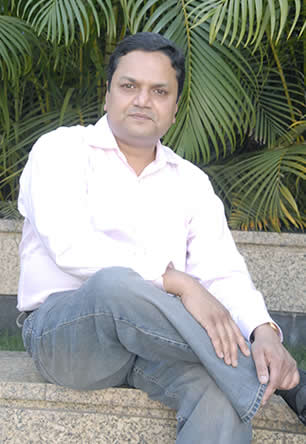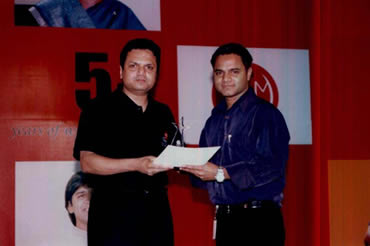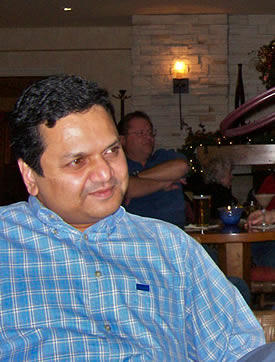
PV Kannan runs 24/7, a $120M call center with 6000 seats. This was one of the top interviews. He’s doing some very sophisticated data prediction to make his business extremely efficient; it’s very impressive. Also impressive is the fact that his company is funded by Mike Moritz, the top VC from #1 VC firm Sequoia Capital. Mike Moritz is well known for funding Yahoo and Google and currently sits on the board of directors of Google. It’s relatively unusual to hear about a call center in Silicon Valley (the HQ is based there), but as we all know direct response marketing is becoming more important so over time I expect to see more companies like 24/7 Customer.
Full Interview Audio and Transcript
Personal Info
Hobbies and Interests: Growing Wine on His Vineyard, Dogs, Family.
Favourite Sports Teams: Indian Cricket Team.
Favourite Books:
- Super Crunchers: Why Thinking-by-Numbers Is the New Way to Be Smart by Ian Ayres
- Judgment under Uncertainty: Heuristics and Biases by Daniel Kahneman, Paul Slovic, and Amos Tversky
Company Website: http://www.247customer.com
Fast Track Interview
Adrian Bye: I’m talking today with PV Kannan, who is the CEO of 24/7 Customer. PV runs call centers in a number of different countries, and he has approximately 6,000 seats around the world. We’re going to talk today about call centers, how the industry works, and learn a little bit more about the space. PV, can tell us a little bit about who you are before we talk about your company?
PV Kannan: I grew up in India. Right after finishing my accounting degree in 1988, I joined Tata Consultancy Services as a programmer. These were the days when offshore programming was just getting started. It gave me a chance to understand offshore from the ground-level perspective.
I immigrated to the United States in 1991 and worked for a couple of high-tech companies. I started my first company in 1995 when the browser had come out and a lot of Internet retail sites were slowly starting. My programming background was on building customer service systems. I thought, what is the impact of the Internet on customer service and sales? That’s when I hit on the idea that service could be delivered through e-mail and chat, and chat would be also a very effective vehicle for converting prospective buyers.
I started a company called Business Evolution, and it became one of the leading providers to one of the top online retailers. In 1999, the company was acquired by our competitor, Kana, for $140 million.
I then started thinking about my next venture. One of the thoughts was combining the two earlier experiences I had with offshore programming and with call center managers to implement chat and e-mail. The managers would be very frustrated with finding people to staff. My idea was if these people are based in India or some other country where they’re educated in English, this would be a very attractive employment opportunity.
In December 1999, I decided this was next company I should launch. In January, I went to India and set up 24/7 Customer in Bangalore. Alta Vista was our first customer. Then we got Shutterfly and a bunch of online companies. Today we have over 6,000 people worldwide.
Adrian Bye: Can you talk about the annual revenues of the company?
 PV Kannan: Sure, the run rate right now is a little over $120 million, and we’re growing roughly about 50 to 60 percent year on year. We’ll probably do $200 million run rate within 12 months.
PV Kannan: Sure, the run rate right now is a little over $120 million, and we’re growing roughly about 50 to 60 percent year on year. We’ll probably do $200 million run rate within 12 months.
Adrian Bye: How much of your business is commission sales and how much is customer service?
PV Kannan: We don’t do what I call pure play commission sales. We get a base amount, and then we obviously get incentive payments. We are far more focused on web-based sales then pure outbound telemarketing.
The sales-based revenue for us is roughly about 30 to 40 percent, but it’s all driven through the web or to inbound sales.
We take off where Google leaves us. Our group does general mathematical models to predict that this visitor is likely to buy. We can then intervene in real time in the form of a chat invitation or a flashing phone number. We use the information about what they have seen to make sure the right offer is made through the chat or with the firm.
Adrian Bye: In terms of your clients, do you ever do straight commission-based?
PV Kannan: We don’t do straight commission-based sales at all. First, we have a better degree of control over what we do, and there’s a long duration to the relationships we accept.
The second reason is that we moved from a model of putting people on feeds to a model of adding value to the entire conversion process through data analytics.
We have no problem working with marketing agencies, as long as they signed on clients on a long-term basis and have predictability. They add value in form "X," and we add value in form "Y" and keep the end-client happy.
Adrian Bye: Why are you at $120 million today which is big compared to a lot of other very small call centers around the world?
 PV Kannan: We’ve made the upfront investment in terms of time and commitment to build a solid business. If you look at the carryover to grow from $120 million to $180 million or $200 million next year, it’s because I made this carryover almost 90 to 95 percent of my revenue, so whatever I add sticks. In the other types of contracts, you’re constantly replacing revenues you are losing because your mix of business is constantly changing.
PV Kannan: We’ve made the upfront investment in terms of time and commitment to build a solid business. If you look at the carryover to grow from $120 million to $180 million or $200 million next year, it’s because I made this carryover almost 90 to 95 percent of my revenue, so whatever I add sticks. In the other types of contracts, you’re constantly replacing revenues you are losing because your mix of business is constantly changing.
We have set up our organization to be more geared toward client relationships, account management, and delivery of critical information on an hourly or daily basis to our clients. This is quite a lot of investment upfront. However, it’s far more sustainable, and we are aligned to their monthly, quarterly, and yearly goals, and then their three-year outlook.
Adrian Bye: How does it work with your employees with commission and base?
PV Kannan: Essentially, they are base wage plus the upside. The reason for that is it’s not so much that our model is back-to-back where we go to our agents and say, "Here is your base salary and we’ll give you the same commission." We are introducing this whole layer called advanced data modeling because we don’t believe that if leads come in and I just use my charms to convert it to be as effective as actually having the basis for figuring out with whom you should be talking or chatting. That distinction is why we insist on a base because we need to fund that and make sure it’s a cost of entry.
Someone approaches us and says, "Here’s how I sell. Can you help me with staffing?" They don’t believe that it’s going to be a real business. For me, a straight commission is almost very speculative, but then you don’t believe that you may sell anything.
For us to cover and ensure the investments we make, all of our contracts are structured as the best case. Then we get a percentage of what we call incremental sales, so it’s not just sales.
If a normal call center gives them 100 leads and they convert 10, we only take commission on the additional five or 10 that we produce, not on the first 10. We pack in a lot more value. The way we measure ourselves is for every dollar you spend with us, how much revenues are you generating? Depending on an industry, a dollar may result in $10 or $20 in revenue, and that real-time measurement and feedback is what makes it very attractive to our clients.
Adrian Bye: If you’re saying a normal call center can convert 10 leads out of 100 and you’ll come along and only take commission on the extra five, how are you generating 50 percent more sales than everybody else?
PV Kannan: That’s where the modeling comes into play. For example, in telemarketing, you’d produce a file and say, "Here are 100,000 people who have expressed some interest in the product. Go call them, and close it." We would have what we call training the model, and in some of these industries, you already have a model. We know, depending on zip codes, the likelihood they would buy a product of this nature for $30 versus $20. What is the success rate? What times of the day do people pick up their phones? It is fairly integrated with about 20 or 30 different variables, which keeps changing minute-by-minute.
 We will take the data, train it and then say, "You know what? Out of these 100,000 leads, I would not even bother calling those 20,000 people." It’s a waste of time because they’re probably so low that I’m going to ignore it. We test assumptions with the classic A-B testing. You’d call 2,000 out of that large number to show that we did the right file.
We will take the data, train it and then say, "You know what? Out of these 100,000 leads, I would not even bother calling those 20,000 people." It’s a waste of time because they’re probably so low that I’m going to ignore it. We test assumptions with the classic A-B testing. You’d call 2,000 out of that large number to show that we did the right file.
Then I’ll just concentrate on high probability deals and make sure that offer is crafted to satisfy their needs.
That’s how we get the conversion. On the Web site, we take Omniture data and all the other data that we track and build a model that will say, "This was what they were looking for whether it is a credit card or this appliance or whatever they’re looking at and really going to buy. What can we do to influence that sale?"
Adrian Bye: You’re using predictive modeling or score carding to figure out where you should be spending your time on your leads?
PV Kannan: That’s correct. I think this is the trend of the future. I don’t know if you’ve had the chance to read Super Crunchers by Ian Ayres. Essentially, he teaches every part of decision-making. He gives a wide-range of decisions, from what ads we see online to public policy decisions, where this kind of score carding and advanced data modeling is making a huge impact.
We’ve finally reached the stage where all the data is finally accessible. The cost of computing has gone down; the cost of storage has gone down. You now have the luxury to load up everything that you can attach and then store it before you just let go of this data. Then you have superior computing power and you have tools like SAS and other things that can crunch it literally within minutes, not days. We’ve entered the golden era where we can actually make sense of all this data that we are collecting.
Adrian Bye: Do you outsource your score carding to someone like Fair Isaac or do you do it internally?
PV Kannan: We do it internally with the 50 or 60 people with Ph.D.s and statisticians.
Adrian Bye: At a typical call center, an agent doesn’t last more than six to 12 months, and then they burn out. How long do your sales agents typically last?
PV Kannan: Our sales agents typically last 18 months, but we put them in a globe track. Essentially, that’s where the non-pure commission model helps us because we can rely on longevity.
The agent has a career track. At any point, they can decide to become a team lead or to go into operations and become a manager. There’s a defined career path and education to support them. Within three years, they can actually move to other areas if they show an aptitude for data. They can move into some of the elementary data modeling. If they happen to be math wizards, then they can keep moving up. They can become trainers. They can become more effective in handling quality.
We give them a whole set of options, so they don’t see themselves as someone who makes a bunch of money and then leaves.
Adrian Bye: Do you still have a certain amount of churn and burn in your business regarding personnel?
PV Kannan: Oh, absolutely! Perhaps the biggest churn is in the first 90 days when someone comes in and says, "I really don’t like this. This is not really me." For us, after 90 days, the churn really reduces to less than 10 percent.
Adrian Bye: What’s the number of your total employees?
PV Kannan: We have 6,200 employees and 6,000 seats. Right now, we’re only using probably 5,400 seats. We’re not fully optimized yet because we keep adding capacity in new regions as we are developing.
We have 4,000 in India, a little over 1,000 in Philippines, and about 1,200 divided between Central America and China. We do have close to 100 people in Belfast and Northern Ireland. We have about 25 employees in the United States, which is the sales team, account management, and some of the technology staff because we maintain switches and dialers. We have about half a dozen employees in the UK. Almost a third of our revenues come from the UK, about 50 percent from the United States, and the rest from Australia and Canada.
Adrian Bye: How do you manage all those guys?
PV Kannan: We anchor around our clients. There’s usually a VP level for all the large clients that contribute more than a third in a year for us, and they are the single point of contact for our clients. They essentially, from my perspective, run the P&L. From the client’s perspective, they are responsible for the performance and making sure that they deliver day-on-day what we promise.
We have a chief operating officer in a global role. She’s American but lives in India. She basically has all the country heads reporting into her, and underneath the country heads are the VPs who actually run the clients. Each client has its own dedicated team that they’re head charting, training, and quality with everything packaged in, so we can hold that unit fully accountable.
Adrian Bye: How does your chat work? Why is it good?
PV Kannan: The structure of the entire chat is like a sales program.
In terms of the platform itself, we work with most of the popular vendors of self-link chat systems. What we really play in is the mathematical modeling and making sure we understand the behavior and conversions and then increasing that conversion and getting paid on that incremental lift.
We target who’s likely to buy, and then they get an invitation that says, "Hey, if you have any questions at anytime, just click here. There’s a live agent available." Most of the time, when we look at the questions, those are not various FAQ kind of questions. It’s real sales assistance where you are using your persuasion skills to sell. That’s where I think human beings are really good.
Adrian Bye: Thank you very much for taking the time to talk to us.
PV Kannan: Thanks for having me.









